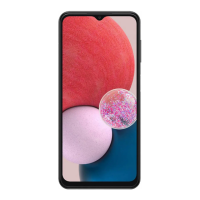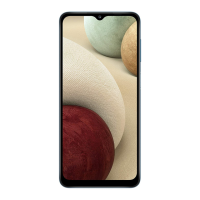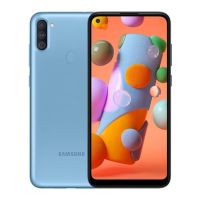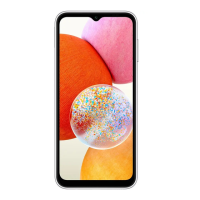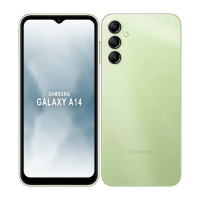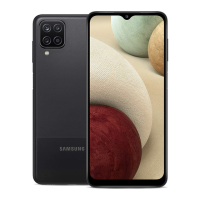Do you have a question about the Samsung SM-A136U and is the answer not in the manual?
Explains symbols used in the manual for warnings, notes, and navigation.
Key warnings for user safety, children, pets, and hearing protection.
Cautions for installation, battery handling, explosive environments, and repetitive motion.
Guidelines for safe driving, medical equipment interference, and aircraft use.
Advice on handling the phone carefully, protecting it from damage, and battery precautions.
Instructions on normal operation, servicing, battery life, SIM/memory cards, and emergency services.
Explains RF energy, SAR measurement, and FCC exposure limits for wireless phones.
Discusses scientific evidence on wireless phone health effects and FDA's role.
Summarizes research results and outlines needed studies on RF exposure effects.
Provides tips to reduce RF exposure and discusses concerns about children's phone use.
Evaluates hands-free kits and accessories claiming RF shielding.
Tips for using phones safely while driving, including hands-free and call management.
Discusses interference with pacemakers, hearing aids, medical devices, vehicles, and facilities.
Instructions for potentially explosive areas and making emergency calls.
States compliance with FCC Part 15 rules and conditions for operation.
Warns against unauthorized modifications, accessories, and physical damage to the phone.
Guidelines for phone servicing, storage, and use on aircraft.
Tips for signal reception, power save feature, and battery precautions.
Advice on keeping the phone dry, clean, and avoiding damage from environmental factors.
Lists items typically included in the product box upon purchase.
Details the phone's keys, display areas (icon line, text area, softkey line), and icons.
Steps for inserting SIM card and charging the battery for the first time.
Explains the visual and audible cues for a low battery status.
Instructions for powering the device on/off and switching to offline mode.
Guide to navigating menus, adjusting volume, and changing profiles/ringtones.
Steps for creating custom phone profiles, setting wallpaper, themes, and menu shortcuts.
Procedures for initiating, receiving, and terminating phone calls.
How to use the speakerphone feature and adjust call volume.
Steps for composing and sending SMS, MMS, and email messages.
Explains different modes (ABC, T9, Number, Symbol) for entering text.
Guide on how to add new contacts and search for existing ones in the phonebook.
How to turn Bluetooth on/off, manage visibility, and pair devices.
Steps to search for, pair, and manage Bluetooth-enabled devices.
Instructions for transferring files via Bluetooth and managing data reception.
Using Remote SIM mode and activating/deactivating Wi-Fi.
Steps to find, connect, and customize WLAN connection profiles.
Connecting via WPS and activating the Mobile AP feature.
Turning Wi-Fi Direct on/off and configuring its settings for device connections.
Compliance with Canadian ICES-003 and Industry Canada RSS standards.
Selecting USB modes for PC connection (PC Studio, Media Player, Mass Storage).
Solutions for SIM, lock, PIN, PUK messages and network unavailability.
Troubleshooting when calls are not dialled or the other party cannot hear.
Addressing poor audio quality, contact dialing errors, battery charging issues, and phone heating.
Explains testing and use of device with hearing aids for newer technologies.
Details FCC requirements for device compatibility with hearing aids.
Explains symbols used in the manual for warnings, notes, and navigation.
Key warnings for user safety, children, pets, and hearing protection.
Cautions for installation, battery handling, explosive environments, and repetitive motion.
Guidelines for safe driving, medical equipment interference, and aircraft use.
Advice on handling the phone carefully, protecting it from damage, and battery precautions.
Instructions on normal operation, servicing, battery life, SIM/memory cards, and emergency services.
Explains RF energy, SAR measurement, and FCC exposure limits for wireless phones.
Discusses scientific evidence on wireless phone health effects and FDA's role.
Summarizes research results and outlines needed studies on RF exposure effects.
Provides tips to reduce RF exposure and discusses concerns about children's phone use.
Evaluates hands-free kits and accessories claiming RF shielding.
Tips for using phones safely while driving, including hands-free and call management.
Discusses interference with pacemakers, hearing aids, medical devices, vehicles, and facilities.
Instructions for potentially explosive areas and making emergency calls.
States compliance with FCC Part 15 rules and conditions for operation.
Warns against unauthorized modifications, accessories, and physical damage to the phone.
Guidelines for phone servicing, storage, and use on aircraft.
Tips for signal reception, power save feature, and battery precautions.
Advice on keeping the phone dry, clean, and avoiding damage from environmental factors.
Lists items typically included in the product box upon purchase.
Details the phone's keys, display areas (icon line, text area, softkey line), and icons.
Steps for inserting SIM card and charging the battery for the first time.
Explains the visual and audible cues for a low battery status.
Instructions for powering the device on/off and switching to offline mode.
Guide to navigating menus, adjusting volume, and changing profiles/ringtones.
Steps for creating custom phone profiles, setting wallpaper, themes, and menu shortcuts.
Procedures for initiating, receiving, and terminating phone calls.
How to use the speakerphone feature and adjust call volume.
Steps for composing and sending SMS, MMS, and email messages.
Explains different modes (ABC, T9, Number, Symbol) for entering text.
Guide on how to add new contacts and search for existing ones in the phonebook.
How to turn Bluetooth on/off, manage visibility, and pair devices.
Steps to search for, pair, and manage Bluetooth-enabled devices.
Instructions for transferring files via Bluetooth and managing data reception.
Using Remote SIM mode and activating/deactivating Wi-Fi.
Steps to find, connect, and customize WLAN connection profiles.
Connecting via WPS and activating the Mobile AP feature.
Turning Wi-Fi Direct on/off and configuring its settings for device connections.
Compliance with Canadian ICES-003 and Industry Canada RSS standards.
Selecting USB modes for PC connection (PC Studio, Media Player, Mass Storage).
Solutions for SIM, lock, PIN, PUK messages and network unavailability.
Troubleshooting when calls are not dialled or the other party cannot hear.
Addressing poor audio quality, contact dialing errors, battery charging issues, and phone heating.
Explains testing and use of device with hearing aids for newer technologies.
Details FCC requirements for device compatibility with hearing aids.
| Model | SM-A136U |
|---|---|
| Network Technology | GSM / HSPA / LTE |
| Weight | 195 g (6.88 oz) |
| SIM | Single SIM (Nano-SIM) or Dual SIM (Nano-SIM, dual stand-by) |
| Display Type | PLS LCD |
| Chipset | Exynos 850 (8nm) |
| GPU | Mali-G52 |
| Main Camera Features | LED flash, panorama, HDR |
| Main Camera Video | 1080p@30fps |
| Selfie Camera Video | 1080p@30fps |
| Loudspeaker | Yes |
| 3.5mm jack | Yes |
| Bluetooth | 5.0, A2DP, LE |
| Positioning | GPS, GLONASS, GALILEO, BDS |
| USB | USB Type-C 2.0 |
| Virtual proximity sensing | Yes |
| Battery | Li-Po 5000 mAh, non-removable |
| Charging | 15W wired |
| Build | Glass front, plastic back, plastic frame |
| Display Size | 6.5 inches |
| Display Resolution | 720 x 1600 pixels |
| CPU | Octa-core 2.0 GHz Cortex-A55 |
| RAM | 4 GB |
| Internal Memory | 64 GB |
| Main Camera | 50 MP, f/1.8, (wide), PDAF |
| Selfie Camera | 5 MP, f/2.2 |
| WLAN | Wi-Fi 802.11 a/b/g/n/ac, dual-band, Wi-Fi Direct |
| NFC | Yes |
| Sensors | Accelerometer |
